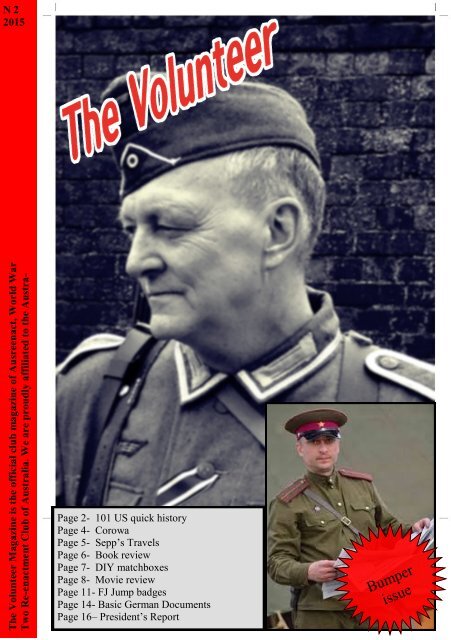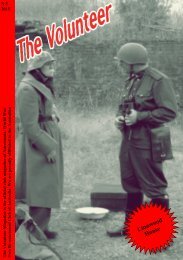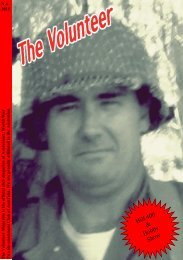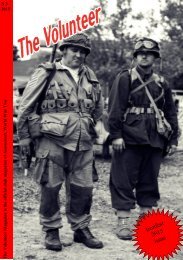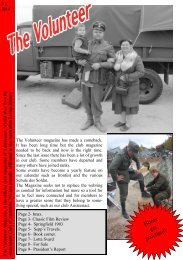The Volunteer Vol 2
Ausreenact magazine, by its members for its members. Enjoy!
Ausreenact magazine, by its members for its members.
Enjoy!
You also want an ePaper? Increase the reach of your titles
YUMPU automatically turns print PDFs into web optimized ePapers that Google loves.
N 2<br />
2015<br />
<strong>The</strong> <strong><strong>Vol</strong>unteer</strong> Magazine is the official club magazine of Ausreenact, World War<br />
Two Re-enactment Club of Australia. We are proudly affiliated to the Austra-<br />
Page 2- 101 US quick history<br />
Page 4- Corowa<br />
Page 5- Sepp’s Travels<br />
Page 6- Book review<br />
Page 7- DIY matchboxes<br />
Page 8- Movie review<br />
Page 11- FJ Jump badges<br />
Page 14- Basic German Documents<br />
Page 16– President’s Report<br />
Bumper<br />
issue<br />
1
101st US.... A brief history<br />
<strong>The</strong> 101st can trace its linage back to November of 1918, when it was<br />
first originally organised as a standard Infantry division. Sadly the division<br />
was demobilised the following month. In the 1920s the division was<br />
again reorganised as a reservist division in Milwaukee, Wisconsin and<br />
remained like this into the early 1940s. <strong>The</strong> Division was disbanded early<br />
in August 1942, only to be activated once again on the 16th of August<br />
1942 at Camp Claiborne Louisiana.<br />
Its here at Camp Claiborne under the<br />
command of Major General William C<br />
Lee, that the 101st took on the shape of<br />
an Airborne division. Originally the<br />
101st was to consist of two Glider Infantry<br />
Regiments (GIR) and one Parachute<br />
Infantry Regiment (PIR). <strong>The</strong>se<br />
units were 327th GIR, 401st GIR and the 502nd PIR. <strong>The</strong> 502nd being<br />
Stationed at Fort Benning, Georgia. In the following months they were<br />
joined by two more Parachute Infantry Regiments the 501st PIR and the<br />
506th PIR both from Camp Toccoa Georgia. It was during this time that<br />
the 101st’s CO noted that the division had no real history, but it would<br />
have a “rendezvous with destiny”. Little did he know how true those<br />
words would be.<br />
In October of 1942 the division moved to Fort Bragg, North Carolina.<br />
Here the whole division was now on one base, where they continued to<br />
consolidate their training. In early march of 1943 the 101st had a change<br />
of command, the division was handed to Brig. Gen. Maxwell D. Taylor.<br />
Around the same time the division lost the 401st GIR, with it now being<br />
transferred to the 82nd Airborne Division.<br />
In September of 1943 the 101st departed the United States for the European<br />
<strong>The</strong>atre of Operations. Once in England the Division continued to<br />
train in infantry tactics and conduct training jumps. <strong>The</strong>y were training to<br />
jump into Hitler’s fortress Europa. Men of the 101st Division fought on D<br />
-Day in Normandy as well as in Operation Market Garden in Holland<br />
with great success.<br />
2
<strong>The</strong> Division became well known for their actions in the Ardennes<br />
Forrest in Belgium, in an action that has become known as the Battle<br />
of the Bulge. <strong>The</strong> men of the 101st were the first allied troops to<br />
enter Berchtesgaden, Hitler’s alpine retreat.<br />
<strong>The</strong> men of the 101st’s Easy Company were the first troops to enter<br />
Hitler’s eagles nest, his mountain top home.<br />
In August of 1945 the division was moved back to France where it<br />
started to train for a combat jump into Japan, however these plans<br />
were cancelled when Japan surrendered.<br />
<strong>The</strong> 101st Airborne Division was yet again deactivated on the 30th<br />
November 1945, however this was not the end of the 101st’s story.<br />
<strong>The</strong> immediate<br />
post war period<br />
marked an intermittent<br />
existence<br />
for the 101st Division,<br />
with several<br />
reactivations and<br />
deactivations at<br />
Camp Breckinridge,<br />
Kentucky<br />
and at Fort Jackson,<br />
South Carolina.<br />
<strong>The</strong> 101st Division was officially reactivated for the last time on<br />
the 12th September 1956 at Fort Campbell, Kentucky. Since then<br />
the Division has served in places like Vietnam, Somalia, Bosnia<br />
and Kosovo to name just few.<br />
I can’t help but wonder if when Major General William C Lee said<br />
that the Division would have a “rendezvous with destiny”, if he<br />
actually knew what the division would go on to achieve.<br />
3
Corowa swim-in 2015<br />
<strong>The</strong> Corowa Swim-in is regarded as the largest gathering of Military vehicles<br />
in Australia. <strong>The</strong>re you’ll find jeeps galore, lots of ww2 trucks and<br />
a number of bikes. If you have a lazy $50k you can even buy a tank or<br />
for 70k you can get a BMW R75 combo. Ausreenact members were<br />
there again this year to represent the club and to add something special<br />
to the event.<br />
We hope to be there again next year, bigger and better.<br />
Dead Funny<br />
Jokes from wartime Germany…<br />
In Italy, there’s a new dance craze, it’s called the Retreat and<br />
it goes like this: you take one step forward, two steps back,<br />
spin around your axis and hide behind your partner.<br />
Two old acquaintances run into one another in a concentration<br />
camp. “Why are you here?” asks one. “On May 10, I said<br />
that Rudolf Hess was crazy,” the other answers. “And yourself?”“<br />
On May 15, I said Hess wasn’t crazy.”<br />
4
Giessen Winkeltürme<br />
In and around Geissen, in central Germany, you can easily locate quite<br />
a few of these unique air-raid shelters designed by Leo Winkel in 1934.<br />
<strong>The</strong>y were usually constructed around industrial and railway centres,<br />
and Wehrmacht posts. All up, about 98 were built in five similar formats.<br />
Sepp found this particular one on the former Verdun-Kaserne and<br />
decided to sneak in and have a look. Note the numbered seating on the<br />
curved benches, the ladder to upper and lower levels, the signage to<br />
indicate how many could be accommodated on each floor, and parts of<br />
the ventilation system.<br />
5
MEMBERS BOOK REVIEWS<br />
Heroes in Death, the von Blücher brothers in the Fallschirmjager Crete<br />
May 1941. By Adrian Nisbett<br />
Unfortunately this has no ‘Saving Private Ryan’ Hollywood finish.<br />
This book looks at three brothers involved in Operation Mercury:<br />
Wolfgang, Lebrecht and Hans Joachim von Blücher. <strong>The</strong> von Blücher<br />
brothers were Fallschirmjager jumping into Crete on 20 May 1941. Heroes<br />
in Death recounts the brothers’ lives before the war, their training<br />
as Fallschirmjagers, the action for which Wolfgang was awarded the<br />
Knight’s Cross, how they died in the invasion<br />
of<br />
Crete and the aftermath of their deaths. This<br />
is<br />
the first full and accurate account of a little<br />
known but remarkable story.<br />
<strong>The</strong> von Blücher family had four sons and<br />
one daughter, Wolfgang (1917), Adolf<br />
(1918), Gertrud (1921), Lebrecht (1922) and<br />
Hans Joachim (1923). <strong>The</strong> eldest brother<br />
Wolfgang had begun his training in early<br />
1940 in the Heer paratroop detachment which<br />
was integrated into the Luftwaffe.<br />
Wolfgang was involved in the Olso and Narvik assaults where he received<br />
the Iron Cross, first and second class. <strong>The</strong> next month he took<br />
part in the invasion of Holland and for leadership and courage during<br />
the assault on the Dordrecht bridges he received the Knight’s Cross.<br />
Lebrecht and Hans Joachim joined the Fallschirmjagers in admiration<br />
for their older brother.<br />
Lebrecht jumped onto Crete with the 7 th company of IIFJR1 to the west<br />
of the airfield at Heraklion where elements of the Australian 2/4 were<br />
defending. Within twenty minutes Lebrecht’s company was wiped out,<br />
every man shot down as they tried to release their parachutes or dead<br />
before they hit the ground. Exactly how Lebrecht died would never be<br />
discovered.<br />
6
Hans Joachim 1 st company and Wolfgang 2 nd company IFJR1 jumped to<br />
the east of the airfield. Wolfgang’s position came under fire and by the<br />
morning on 21 st May he was surrounded on exposed rocky ground atop a<br />
hill. Hans Joachim was in the group trying to rescue Wolfgang. Hans<br />
Joachim was within 300metres of Wolfgang’s position and watched<br />
helplessly as repeated assaults failed to get through to the besieged<br />
group. Suddenly from the German lines came a horse ridden by Hans<br />
Joachim with canisters of ammunition. Inevitably both horse and rider<br />
were cut down but the ammunition was retrieved by the besieged Fallschirmjagers.<br />
By afternoon on 21 st Wolfgang had run out of ammunition.<br />
At this point Wolfgang was shot and killed trying to retrieve a British<br />
gun and ammunition. Shortly after Wolfgang’s death the remaining Fallschirmjagers<br />
surrendered.<br />
<strong>The</strong> fourth brother Adolf died in 1944.<br />
DIY German WW2 Matchboxes<br />
by Werner Riedel<br />
Ever wanted some period looking German WW2 matchboxes<br />
or Streichholzschachteln? Like most matchboxes of the WW2 period,<br />
these were constructed from birch ply. Slapping on a reproduction label on<br />
a box of RedHeads just doesn’t cut it in my opinion. For a more authentic<br />
look you can purchase 5 wooden matchboxes from MatchHouse on<br />
Etsy.com for AUD 22.00 shipped to Australia. EBay<br />
sellersurplus_sammy aka Firebasenam sells an assortment of reproduction<br />
matchbox labels at a cost of AUD 3.95 shipped. <strong>The</strong> labels can be easily<br />
glued onto the matchboxes after they are trimmed to size. <strong>The</strong> matchboxes<br />
are slightly larger than the period ones - 57mm x 38mm x 16mm as opposed<br />
to 51mm x 35mm x 13mm – but the labels are actually catered for<br />
the more contemporary box dimensions. If you want to go that little bit<br />
further, you can run a purple highlighting pen across the exposed birch ply<br />
to simulate the colouring often associated with period matchboxes. And<br />
there you have it! Viel Vergnügen!<br />
7
(Furlough on Oath). DVD 1938<br />
What lifts this otherwise fairly predictable<br />
narrative just a little above the ordinary, is<br />
the diverse range of minor stories which it<br />
very simply crafts, and which thus form<br />
and drive it. <strong>The</strong>se stories of the common<br />
man and woman are played out effectively<br />
against a backdrop of impending<br />
social upheaval; of rationing at home, of<br />
nascent socialism, and the ultimate betrayal<br />
of the military by the left, the profiteers<br />
and the defeatists.<br />
It is 1918, and the fifth year of the Great<br />
War is looming. Despite a period of convalescence,<br />
the young Lt. Prätorius and<br />
his men are destined once more for the<br />
front. But for this trainload of mostly Berliners,<br />
there is no plan for any home<br />
leave, and even with a 6 hour stop-over in<br />
their home city before the next train, they<br />
will be restricted to the station. For all,<br />
this is an intolerable situation.<br />
We are entitled to leave! No. A hero’s<br />
death is all we are entitled to.<br />
Berlin however is a different city to the one they left so many years ago. It is a haven<br />
for deserters. A man could quite easily disappear if he wished. And while Prätorius<br />
trusts his men implicitly, he knows the risks. It would be his head that would be<br />
served up should any of them be given permission to visit family and loved ones, and<br />
not return. No. Again, no!<br />
But of course, cracks once opened quickly become floodgates. First it is Hartmann,<br />
who on more than one occasion had saved the Lieutenant on the battlefield. You must<br />
be back by 6!<br />
On my word of honour! Urlaub auf Ehrenwort!<br />
His is soon followed by the inevitable swarm of requests… please, my pregnant<br />
wife… please, my mother…. my music professor… And so it goes. <strong>The</strong> handshake.<br />
Urlaub auf Ehrenwort! Yes, I’ll be back half an hour before our train leaves, until all<br />
that is left is a handful of non-Berliners, there to wait it out with the anxious Prätorius.<br />
8
It is interesting to note that during these scenes, we hear the first rumblings of revolution<br />
in the new Berlin, as a group of civilians exhort the men to go home: “[<strong>The</strong> war] is all<br />
rubbish anyway, let them finish the war themselves!”<br />
For the men who have hurriedly, expectantly, departed, to take in the ecstasy that is a<br />
mere handful of hours of freedom, their anticipation is met<br />
Of note among the cast is the inclusion of Fritz Kampers, who plays Gefreiter Hartmann;<br />
the first to be given leave and (almost) the last to return. Kampers was as prodigious a<br />
performer as he was an outstanding one, appearing in such classics as Westfront 1918<br />
and the sublime Kameradschaft. As an actor, he is on another plane entirely to the balefully<br />
pretentious, though sadly ubiquitous, Carl Raddatz, whose thankfully minor role<br />
here may have been his best-ever performance.<br />
with all manner of realities: the delights of family, of culture and aesthetics; the temptations<br />
of the flesh, or of Communism or of the high life. Each man or group to his own.<br />
Finding love or losing it. From bliss and betrayal, they will experience it all in their own<br />
way.<br />
And again those signposts to unrest: “End the War”…”Revolution Will Come”. <strong>The</strong> posters<br />
on the wall of the bar crowded bar, with its Communists, shirkers and deserters, all<br />
out for a good time.<br />
“Emile, this is how we live everyday! You’d be mighty stupid if you went out again onto<br />
that mess. We need a few more brave men for the Party!<br />
<strong>The</strong> hours tick by. 6.10, and the train leaves in 20 minutes. None have returned.<br />
But you can probably anticipate the final scenes.<br />
Yes, they all do – all of them - in their own way, in their own nick of time.<br />
That “damned sense of duty” called them back, once more to war.<br />
And of course, in 1938 German when Urlaub in Ehrwort was released, there could be no<br />
taint, no question of anything other than honour and commitment when it came to portraying<br />
the common soldier, stabbed in the back as he was to be by the November Criminals.<br />
<strong>The</strong> appeasers.<br />
From among the ranks who returned, disenchanted, both the left and the right would recruit<br />
support. But it was the right which would benefit overwhelmingly from their numbers,<br />
their sense of duty and their organisational strength.<br />
<strong>The</strong>re can be no denying that this is a relatively minor piece of National Socialist era cinema.<br />
Yet, thanks to the relatively benign script, which is in no way affected by the overt<br />
9
propaganda of so many of its predecessors and contemporaries, it does not suffer at all<br />
as entertainment. Indeed, with war about to come to Germany once more, it would<br />
serve quite nicely as a vehicle for reminding the nation of the values which had served<br />
it so well in the past: honour and faith. However tragically misguided such faith would<br />
ultimately prove to be.<br />
tirely to the balefully pretentious, though sadly ubiquitous, Carl Raddatz, whose thankfully<br />
minor role here may have been his best-ever performance.<br />
See below a poster of the remake from the 1950’s and a couple of stills from the<br />
original film.<br />
10
LUFTWAFFE PARATROOPER QUALIFICATION BADGES<br />
When the Nazis came to power in 1933, Göring was appointed Minister of the<br />
Interior and head of the Prussian police force. It was in this capacity that Göring<br />
began training a handful of Berlin policemen in parachuting. Impressed with the<br />
Soviet display he had witnessed in 1931, Göring’s intent was to create a special<br />
police task force that could catch criminals off guard by dropping in on them<br />
from the air.<br />
On 1 June 1935, Göring was promoted to Commander-in-Chief of the Luftwaffe,<br />
not wanting to lose control of his paratroopers he transferred the paratroopers to<br />
the Luftwaffe. In March 1936 a parachute school was set up at an airfield in Borstel<br />
near Stendal approximately 100 km west of Berlin.<br />
Formal jump training began on 4 May 1936 with<br />
some 600 paratroopers passing all the physical and<br />
psychological requirements, and having completed<br />
their 6 qualifying jumps.<br />
To recognise the specific achievements of paratrooper<br />
training, the Luftwaffe paratrooper badge<br />
was instituted on 5 November 1936. <strong>The</strong> paratrooper<br />
badge is a qualification badge rather than a combat<br />
ward.<br />
<strong>The</strong> paratrooper badge consists of a laurel and oak<br />
leaf wreath, crossed with a gilded diving eagle<br />
clutching a swastika in its talons. <strong>The</strong> badge is made up of 10 sets of laurel<br />
leaves on the left side and 9 sets of oak leaves on the right. A vertical pin was<br />
soldered directly to the reverse. <strong>The</strong> wreath was to be nickel silver and artificially<br />
oxidised to an antique silver colour. <strong>The</strong> eagle was gilded brass. As the<br />
war continued; after 1942; materials for the construction became scarce and<br />
variations including the use of aluminium and zinc were used in the manufacture.<br />
Some badges had the makers mark stamped in the back of eagle. A number of<br />
manufacturers were used to make the badge, with the classic manufactures being<br />
Assman & Söhne whose eagle had a ‘mother goose’ face while C.E Juncker had<br />
the ‘angry eagle’ face. An example of a C.E Juncker is attached with case. Each<br />
manufacturer had slight variations in badge appearance, size, weight and award<br />
case.<br />
Nearly every qualification badge was also in a cloth version, as a logical solution<br />
to wearing a snag-prone, bulky metal badge, the cloth badge was sewn flush onto<br />
the uniform.<br />
11
Accompanying the presentation of the paratrooper badge was the formal<br />
award document or Verleihungsurkunde. <strong>The</strong> document was a formal recognition<br />
of the completion of training and included the recipient’s name<br />
and rank.<br />
12
A very common signature found on paratrooper badge documents and all<br />
documents is Gustav Kastner-Kirdorf between 1938 and 1942 and his signature<br />
is shown in the example attached. <strong>The</strong> year 1940 would see a massive<br />
expansion of the paratrooper forces, and this is reflected in the control<br />
number at the bottom left. Approximately 2000 Luftwaffe paratroopers<br />
would be trained in the 3 years between 1936 and end of 1939, but that<br />
number would jump to almost 14,000 by the end of 1940.<br />
References:<br />
Wehrmacht awards for members displays the full range of manufactures<br />
badges:<br />
http://www.wehrmacht-awards.com/forums/forumdisplay.php?f=257<br />
<strong>The</strong> German Luftwaffe & Heer Paratrooper Badges of World War II 1936<br />
to 1945 by Thomas Durante.<br />
13
Spot the Difference<br />
When our President was last at Valhalla (the Parthenon-like building on the<br />
Rhein, not the really, REALLY big place up in the clouds) He tried to do a<br />
match-up with an image of the Big Fella in the same spot.<br />
He's (AH) looking at a bust of Bruckner, one of his favourite composers<br />
(after Wagner of course). <strong>The</strong> interior hasn't changed much at all, though<br />
they have moved old Anton to another spot and added a bust of Sophie<br />
Scholl, among others. Our President lined it up based on the busts of the<br />
others around the walls, and the marble patterns of the walls. Yep. Same<br />
spot alright.<br />
Basic German Travel Documents<br />
Amongst the plethora of documents used by the German forces there were a few that<br />
every soldier came across routinely. Other than the vital Soldbuch, the most common<br />
he might see were travel papers. <strong>The</strong>se varied as the war progressed with some<br />
documents being later combined. <strong>The</strong> below list is based on pre 1943.<br />
For a German soldier to travel home from the front on precious leave, the following<br />
documents were required...<br />
Cont next page....<br />
14
Kreigsurlaubschein<br />
= Leave pass<br />
This authorised leave from duty and came in two variants...<br />
1) With a vertical & central green stripe, this indicated that the cost of any travel was to be<br />
paid by the Wehrmacht. This pass had to be accompanied by a Kleiner Wehrmachtfahrschein<br />
with either a red or blue stripe.<br />
2) With no stripe, this indicated that any travel was to be at the soldiers cost. <strong>The</strong> corresponding<br />
Kleiner Wehrmachtfahrschein also had no stripe.<br />
Kleiner Wehrmachtfahrschein<br />
= Travel pass<br />
This pass was in two parts (outbound & return) and was issued in three variants...<br />
1) With a diagonal blue stripe, from the bottom left to top right. This indicated that the<br />
travel was at the Wehrmacht expense and valid for a trip of more than 200km. This often<br />
authorised the use of faster trains.<br />
2) With a diagonal red stripe, from the bottom left to top right. This indicated that the travel<br />
was at the Wehrmacht expense and valid for a trip less than 200km.<br />
3) With no stripe, This gave permission to travel but at the soldiers own expense therefore a<br />
ticket was required.<br />
Entlausungsschein (E-Schein)<br />
= De-lousing certificate<br />
This certificate was needed by every soldier returning from the front to validate that he was<br />
free of lice and nasties. Stamped & authorised by the medical<br />
officer.<br />
Not all troop movement is associated with leave, so if the soldier was away from his unit for<br />
any other reason , then alongside the above he would also have to ensure he had further<br />
documents...or face the consequences.<br />
MarschBefehl<br />
= Movement (Marching) orders<br />
<strong>The</strong>se orders were issued to notify and authorise any official movement of the soldier from<br />
post to post for duty changes. this may have been a transfer to another posting or to attend a<br />
training school. This document authorised absence from a unit, and therefore avoided being<br />
stopped as a deserter.<br />
Sonderausweis D<br />
= Special Mission papers<br />
Special MIssion Document D, D for Dienstreisen (Mission) was issued for purposes of official<br />
military travel. This was for special trips, perhaps to collect vehicles or equipment etc.<br />
This document authorised absence from a unit and therefore avoided being stopped as a deserter.<br />
15
Prasident’s Report<br />
Kameraden,<br />
Welcome to another edition of <strong>The</strong> <strong><strong>Vol</strong>unteer</strong>, compiled by Erich from members’ submissions.<br />
Welcome too to new members Tom and Paul.<br />
Our calendar of events has proven to be a valuable planning tool, even as some dates are<br />
amended, and other items are added to it along the way.<br />
Of equal success has been the paybook system, organised by Ritter and overseen by Jana!<br />
Thank you to all members for embracing this initiative by remembering to bring the booklets<br />
to each event.<br />
Well done to those members who represented us Corowa, and to those who plan on driving<br />
to South Australia in May. I realise that the logistics of such events are quite challenging,<br />
and attendance can be equally difficult due to cost, time and distance, but again, thank<br />
you for your efforts.<br />
Planning for IronFest is well underway and in the coming weeks we will endeavour to<br />
organise a meeting to do what we can to finalise our action sequences and display. If you<br />
are unable to attend this meeting, please make sure you at least keep up to date by checking<br />
your mail. This is terribly important because the webring is THE prime means of<br />
group communication.<br />
Armidale registration details have been posted and I encourage you to attend if at all possible.<br />
Few things build character like sub-zero nights in the bush.<br />
My best wishes to you all for safe travels to and from all our events.<br />
Cheers,<br />
<strong>Vol</strong>ker<br />
16
For Sale !<br />
This section will be open to members to sell any original or reproduction WW2<br />
items. We do not accept responsibilities for items not paid or not delivered.<br />
Current Items:<br />
German M36 Greatcoat, early Sturm. Fits size 42/44. Great quality, correct<br />
length = $180<br />
German Schirmmutze Size 60, White piping for Infantry = $100 ( on<br />
hold )<br />
Original Luftwaffe Wachmantel size 40 =$450<br />
2015 Calendar of Events<br />
April Training event 04/04/15 Ironfest 18-19/04/15<br />
May Adelaide 01-03/05/15 Military Extravaganza NSW<br />
June D-Day Western event 13-<br />
14/06/15<br />
July<br />
Model show Clarendon<br />
05/07/15<br />
August Barbarossa Winter event 01-<br />
02/08/15 Tarago, NSW<br />
AGM 18/07/15<br />
Armidale winter event<br />
September Linwood House Battle of Prague/Western<br />
Front 12-13/09/15, Tarago,<br />
NSW<br />
October<br />
Battle of Berlin, Tarago,<br />
NSW<br />
November Family bbq 01/11/15 Battle of Ardennes, Tarago,<br />
NSW<br />
December<br />
Stalingrad, Tarago, NSW<br />
17
18<br />
<strong>The</strong> volunteer is a club magazine put together by club members for<br />
club members. You are welcome to make suggestions and provide contributions,<br />
please write to us at waffen_su@yahoo.com.au.<br />
This issue could not have been published without the assistance of<br />
Sepp <strong>Vol</strong>ker, Gustav Becker, Werner Riedel, and Klaus Hoffmann.


